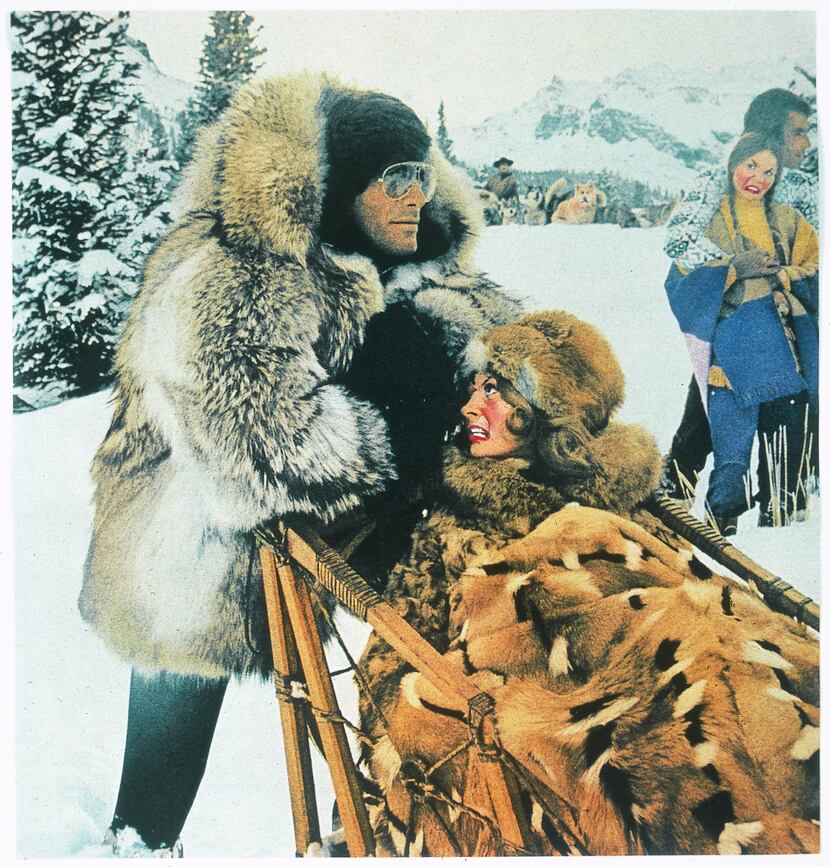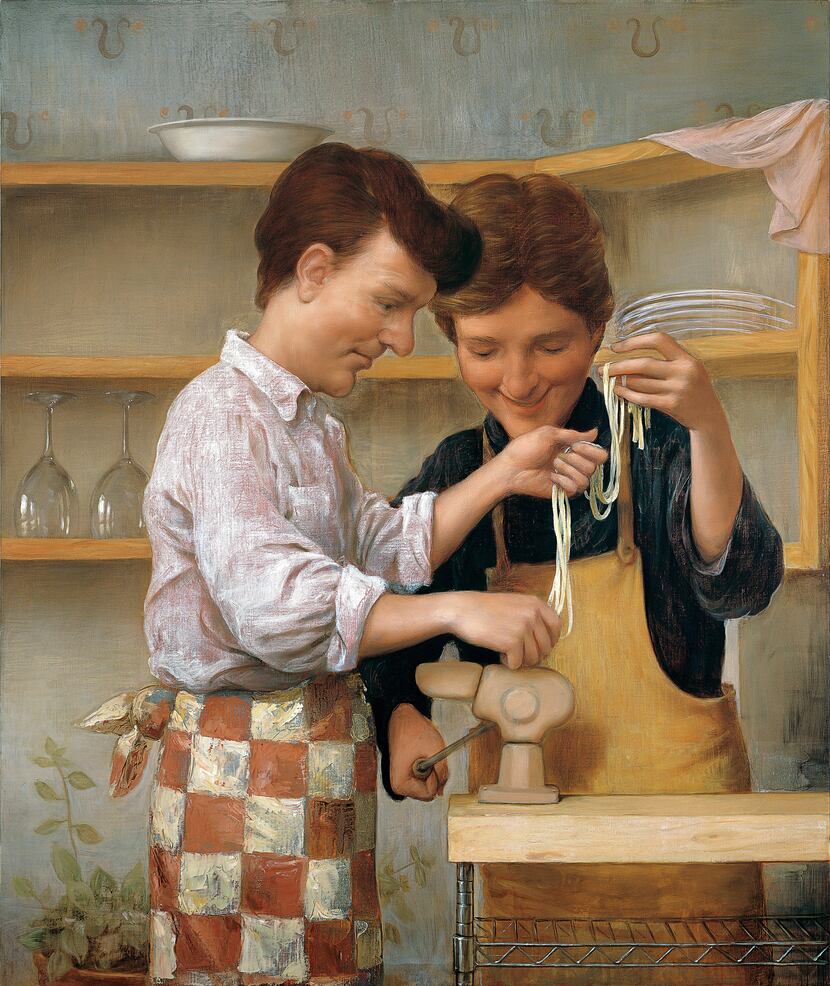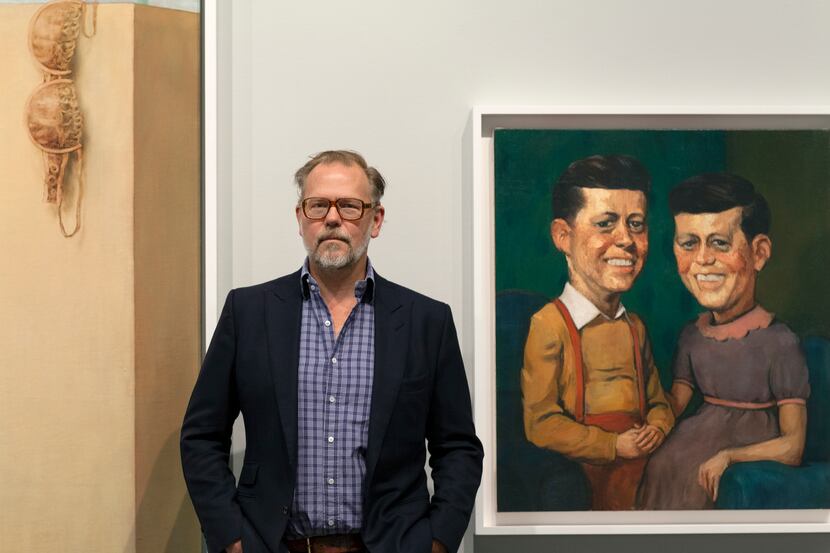John Currin’s “My Life as a Man” at the Dallas Contemporary is the artist’s first museum show in 15 years. It’s also a layered, self-flagellating and perhaps ultimately celebratory look at masculinity.
Curator Alison Gingeras, who previously brought us “Black Sheep Feminism: The Art of Sexual Politics” and McDermott and McGough’s “I’ve Seen the Future and I’m Not Going, a Radical Retrospective,” asks a provocative question with this show: Can a straight white male painter create feminist work?
The fact that Gingeras decides the best affirmative answer to this question is the work of Currin is quite audacious.
Think about it.
Currin, who in 1992 prompted Village Voice art critic Kim Levin to exhort readers to “boycott this show” if they were good feminists because of his grotesque depictions of menopausal women.
Currin, the entitled artist whom one can imagine enjoying a Roxor gin and tonic after driving to his lakeside Maine home in his silver Porsche, before chatting with his good friend, designer Marc Jacobs.
Currin, the art world provocateur, the WASPiest of WASPs, has created an exhibition that is, indeed, in the words of Gingeras, “a feminist show, in a way.”
A careerlong pursuit
It is easy to think of the staging of “My Life as a Man,” which references the 1972 Phillip Roth novel of the same name, as a response to the #MeToo era. However, one of the most refreshing and curious things about the show is that Currin has been painting men and making commentary about a particular type of masculinity throughout his career.
One of the highlights of the exhibition is a set of small works on the back wall of the museum that showcases his 1997 "The Jackass" series. Currin takes 1970s Playboy advertisements and paints over the faces of the women in gouache.

Currin’s jackasses -- the cheerful golfer, sultry tennis pro, handsome sailor, beach cookout bros, playful ranchers -- all become objects of horror instead of objects of desire. The women are revolted, under duress, horrified, scornful and annoyed. The inversion of these Playboy advertisements is so successful because it shifts the gaze, and thus the power, from the smiling, smirking men to the women who were meant to be ornaments of male desire.
It also highlights the violence involved in these sexual fantasies, which reasserts the importance of consent. And the horror is, what if these women never consented? What if men never bothered to ask?
The fact that Currin created this work at the same time he was painting contorted women adds an additional layer to our understanding of him as an artist. It would be highly believable that a queer, millennial woman painted this series last year. This work is Currin’s most direct, surprising and powerful feminist gesture.
However, perhaps it is not surprising that Currin’s best work, in a show about men, is one in which he paints women. Currin prefers to take his men from stock photographs or advertisements; sometimes he starts off by painting the face of a woman and then painting a male face on top of it. Only a couple of the more than 100 images of men that Currin has created are from direct observation.
It is as if thinking of men, which of course for Currin means considering himself, is painful. “The subject of men is a recurring shingles outbreak in my work,” Currin says.
Deflated men
Currin’s men are mostly deflated, sad, pathetic, lost and otherwise unwholesome creatures. They desperately cling to a world where their very existence was powerful, yet because of age or anxiety, the virility of the subjects is fading.
These are not macho men, and rarely are they alone. They cling to their wives or to other men. When they are sexual, they are either disconnected from their own sexual desires or plainly transgressive.
In Lovers In the Country (1993), Currin describes the older, blonder male with his younger blond wife as “having a worried, cyclops eye, he doesn’t know where his life is going.” The man, wearing a white turtleneck and double-breasted brown sports coat, is also a reference to Currin’s father.

This incongruousness of confident outward appearance vs. wandering inner life is seen again, more clearly, in Hot Pants (2010), where an older man is getting fitted for a new suit jacket while wearing shorts and knee-high red socks.
In the mirror, he appears as a rugged and cool Sean Connery type; however, his visage in real life is frailer and less elegant. Currin is depicting the disconnect that these men have between their projected self-image and whom they really are.
This disconnect continues in paintings such as The Wizard (1994) and Office Workers (2002), both of which depict graphic male sexuality.
Yet, the man in both cases isn’t quite connecting with his desire. There is a pictorial frustration that gives the pictures an awkward and stilted presence. In The Dream of the Doctor (1997), the image of a doctor leaning into a screen with a bra hanging from it is terrifying for what it implies but also is male sexuality at a remove -- one can imagine that doctor is wearing gloves and not quite able to fully grasp what he desires.
‘Pictures of male serenity’
Aside from Currin’s portraits of his own children (Francis and Hollis), which are tender and straightforward and help set up what Currin calls his “parade of men” from childhood to old age, the sweetest portrayal of masculinity comes when Currin paints two men together.
Three paintings, Fisherman (2002), which portrays the muscled backs of the artist and his former studio mate, Sean Landers; The Kennedys (1996), which is made with a palette knife and has two images of John F. Kennedy, one in a dress; and Homemade Pasta (1999), which shows two men making pasta together, are examples of what Currin describes as “male Venuses” and “pictures of male serenity.”

The tension, violence and frustration that exist in Currin’s paintings of men and women together float away, and one is left with a sort of unbridled bliss. However, these counterimages are exceptions that prove the rule.
It is hard not to feel a little sad for Currin’s men. It is a rare and honest depiction of white middle- to upper-middle-class masculinity that is slipping. One has to wonder about the world that these men have lived in, one in which their power and existence weren’t always earned.
In the #MeToo era, masculinity and sexuality have to be earned. One is no longer sexually powerful or desirable merely because one is straight or wealthy or white. One has to learn how to ask and receive clear, continuous consent.
For many men and quite a few women, this is terrifying. However, the goal of this pursuit of gender equity is fairly simple: to exist in a world where the best part of our humanity may thrive.
Currin’s men illustrate the downside of living with unearned and unconsidered privilege. When the world changes, when the curtain is lifted, what one is left with is a frail, narrow and diminished version of masculinity desperately clinging to anyone or anything that might continue to prop it up.
Darryl Ratcliff is an artist, poet and cultural organizer based in Dallas. He is the co-founder of Ash Studios, Creating Our Future and Michelada Think Tank.
Details
“My Life as a Man” continues through Dec. 22 at the Dallas Contemporary, 161 Glass St., Dallas. 11 a.m. to 6 p.m. Tuesday through Saturday and noon to 5 p.m. Sunday; closed Mondays. Contains graphic sexual imagery. Free. 214-821-2522. dallascontemporary.org.

